Le petit cirque (the little circus) by Fred.
Fred is the nom de plume and the nom the pinceau of Frédéric Othon Theodore Aristidès. You may have heard about him because of Pilote magazine and his most famous series, “Philemon” (or Philemon if we are talking about the albums). Before that though, Fred had a career behind him as a single-panel gag cartoonist and an absurdist comics artist in the pages of several magazines (the Mad inspired Hara-Kiri especially). It was in said mag that Fred published (from issue # 38, April 1964, until issue # 64, June 1966) his masterpiece “Le petit cirque” (or Le petit cirque if we’re talking about the 1973, 1997 and 2012 album editions). The series, in short episodes of two pages each (with the exception of the first three pages), was also reprinted in Pilote magazine (it appeared in twenty eight issues from # 701, April 1973, until # 741, January 1974).
In 2012 an important retrospective of Fred’s work, Le petit cirque included, was shown at the Angoulême comics convention in France (at the Hôtel Saint-Simon, to be exact). To celebrate the occasion Dargaud published a new remastered edition of Le petit cirque directly shot from the existing original art (which means that pages # 8, 9, 26, 27, 36, 37 – three episodes – didn’t receive the same treatment as the rest of the book; there’s no discernible difference between those pages and all the others though; the editors didn’t explain why this is so). Now I’m waiting for a new edition of Le journal de Jules Renard Lu Par Fred (Jules Renard’s journal read by Fred) with the original page layouts recovered. I hope that someone at Flammarion reads my appeal.
Panel from page 53 of the 1997 edition of Le petit cirque by Fred.
The same panel as above from page 51 of the 2012 edition.
Fred himself said, remembering the series’ first album edition in 1973:
I was pleasantly surprised that time! When we took the pages out of the portfolio to print the album, we realized that the original art had yellowed. Time yellows everything, even the mementos hidden in the bottom of a suitcase. Gray had become sepia which added a melancholia of sorts. I love those atmospheres.
As we can see above the 1997 edition reproduced the sepia tones. The lines are far from crisp though and many wash details were lost to resurface in the 2012 edition only. The latter’s matte paper retains some of the beige flavor that pleased Fred. Since Le petit cirque is a comics masterpiece I would say that this edition is one of last year’s most important comics related events. Unfortunately it passed virtually unnoticed.
The first two tiers of the first page of the series as it appeared in Hara-Kiri # 38, April 1964.
The same tiers published in the albums (in this case, the 2012 edition). As we can see the logo and the episode titles, when they existed, disappeared.
The first two panels of episode two (three in the albums) as published originally in Hara-Kiri # 39, May 1964.
The same panels as published in the 2012 album edition. The logo and episode title were removed, a paper and pencil texture was added (notice the glue smears captured by the photogravure).
We can find the prehistory of Le petit cirque in a couple of circus related cartoon gags, but we can also find it in a series of strange, imaginative professions created by Fred for Hara-Kiri: the knitter of savage balls; the bearded seller of cotton candy (barbe à papa); the representative of holes; the countryside licker of stamps; the celery grinder; the mirror fixer… In one of his “little jobs” Fred created the human time bomb. That’s where the little circus really started: it was destined to be the album’s second episode.
The little jobs: the countryside licker of stamps. Notice the Fredian twiggy tree and the wind. Hara-Kiri # 23, December 1962.
The first half of “L’audition”‘s first page (the audition) with the human cannonball (the human time bomb appears in the page’s second half), Hara-Kiri # 37, March 1964. The little circus before the little circus: it is right there in the second panel.
But we may find the true origins of the little circus not only in time, but also in space, in what Fred calls Constantinople (aka Istanbul). Both of Fred’s parents were Greek living in Turkey when WWI raged on and the war between the two countries was declared in 1919. They both emigrated to meet each other in Paris where Fred was born in 1931.
Fred, again:
It was the first time that I did something solid and everything happened naturally, the ideas, the emotions. Maybe because it’s the story of people without roots, like my parents. After leaving Constantinople they traveled a lot too and it was my father who inspired me to create Léopold. […] The Carmen of Le petit cirque is dark-haired and thin while my mother had brown hair and was rather plumpish, but she inspired me nonetheless.
The family that inspired Le petit cirque: from left to right: Eleni (Carmen), Yanis (Léopold), and little Fred (who, in the album, has no name); Trouville, 1930s.
Fred’s iconography is very personal and explains the strange poetical power of Le petit cirque: the wind, the leafless trees, the circus, the peasants, the authorities, the mirror, the landscape, the city, etc… Apart from that what’s great about Le petit cirque is its rhetorical complexity.
Le petit cirque, page 11 of the 2012 edition.
The above page gives the readers one of the keys to read Le petit cirque: the rhetorical reversal of the situations (the daily life of a patriarchal Mediterranean family is shown as circus acts). Another key is what I called, in Monthly Stumblings # 16, the interpenetration rhetorical mode: two distant spaces meet in a third space where both may co-exist at the same time (more about that later). The last panel shows Fred’s leafless trees with the wind blowing strongly from left to right expelling both the reader – the author too in a nostalgic statement about his childhood? – and the character out of the page (the sudden change of point of view from panel five to panel six shows that it’s time to leave already). The overall atmosphere is scrawny and uncomfortable. The vanishing point in the last panel focus Carmen pulling the circus caravan (Fred explained the metaphor: “the caravan symbolizes the family and the head of the family is the wife”; needless to say that this doesn’t convince me at all…). Notice how the horizon line gets lower and lower until we see a towering caravan getting out of reach. On pages 58 and 59 outraged peasants want to argue with Léopold and Carmen, but are overwhelmed when they find out that the caravan, despite its modest exterior appearance, is in reality a palace (not unlike Snoopy’s doghouse). This, of course, is an hyperbole showing Fred’s huge respect for his creatures.
Carmen discovers the violin tree in page 36 of the 2012 edition.
The violin tree is just one of the interpenetrations that I mentioned above. Others link circus people with animals (a clown is a rooster, etc…). The violin tree is the hope and the means to fulfill one’s dreams. The problem is that Léopold, after picking one of the violins from the tree, breaks a string interrupting the process: the family is doomed never to improve their situation no matter how hard they try.
The first two panels of page 18 of Le petit cirque‘s 2012 edition. To the circus family the city is a menacing, blocky, empty space. Fritz Lang’s expressionist Metropolis isn’t far; an hyperbole, again.
Le petit cirque: second and third tiers of page 48 of the 2012 edition.
In the image above Carmen deflates an overblown bourgeois. The stereotype is a bit blunt, to say the least, but there’s an interesting catch in the sequence: the relation between iconic and verbal expression. Fred puts an idea usually uttered in words (“she deflated him”) into drawings. Something that isn’t that usual in comics. The same thing happens in the rooster/clown interpenetration mentioned above: the clown is visually a clown; we only know that it is in reality a rooster because of what the characters say about him.
I could go on doing close readings of all the episodes of Le petit cirque (like the one in which Léopold and Carmen offer a wheelchair to their son and break his leg in order for him to enjoy his present – which he does, of course), but the above is enough, I guess…
In conclusion: the circus family wanders aimlessly in an inhospitable landscape, is harassed and hated by almost everybody else and they suffer setback after setback, but they continue their journey because they have to, winning a few small victories along the way… We only get to the sense of it all though after decoding the logic of the book which is the nonlinear, oblique logic of dreams.
Fred sets his little creatures in motion; second tier of Le petit cirque’s 2012’s edition’s last page. Another narrative device: self-referentiality.
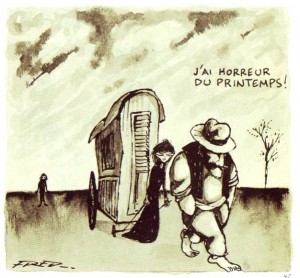
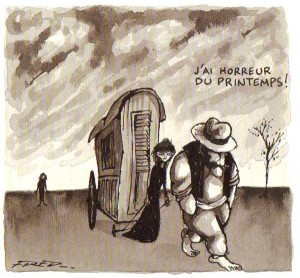
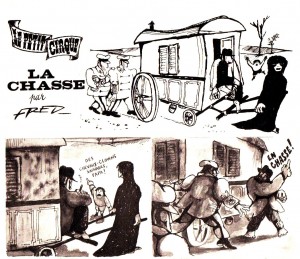
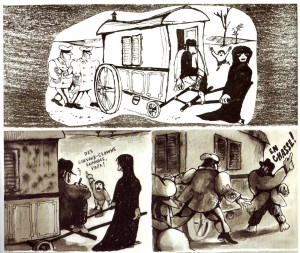
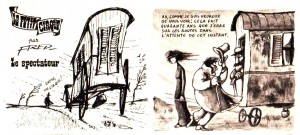
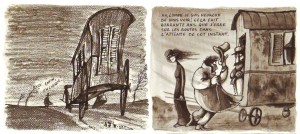
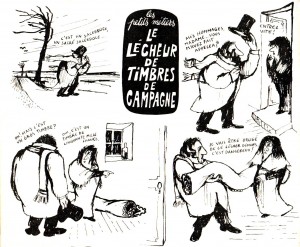

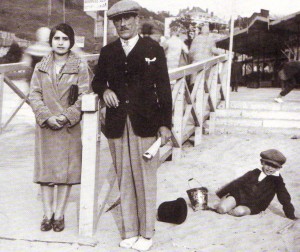
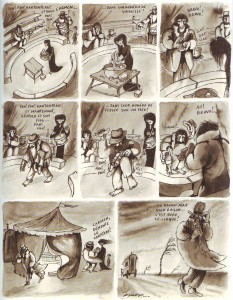
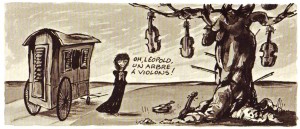
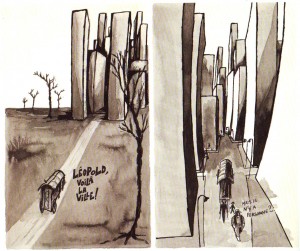
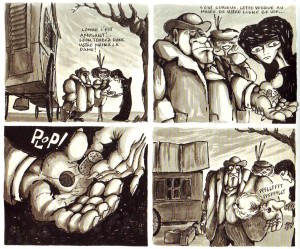
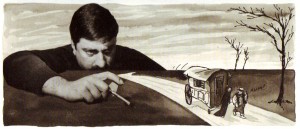
The art is amazing. Thanks for posting these Domingos.
You’re welcome, Noah. Fred deserves to be better known not only in North America, but everywhere.
I wish the process of producing non-japanese comics in north america wasn’t so slow. I wish there was a large community dedicated to scanning and translating french and spanish comics like there is for manga. Most manga scanlated is trash for teens, bu the fandom is large and diversive to inspired a few groups to translate alternative and avant manga.
If such a community for non-japanese comics existed and was large enough, we would eventually have a group that would translate avant-garde comics such as this.
The only publisher in North America putting French-Belgian comics out there is Kim Thompson (mainly Tardi these days). He can tell you how difficult it is. Translations of European comics could be found at Comix Influx, but the site seems to be down.
I would be happy to be a part of that team. I would just need to learn French first…
Great comics.
Fred (particularly the PHILÉMON material) is certainly on my short list of projects I’d love to do — I remember Art Spiegelman urging me to do so years and years ago — but the cold hard truth is that virtually every one of our foreign books excepting Jason (who I think more of as a “global” cartoonist, like Max Andersson) and some of the Tardis are basically breakeven at best, usually active money-losers. (And they usually only achieve breakeven-ness because I translate them in my spare time and thus we don’t spend any money on translations per se.) So I really have to pick and choose…
The nice thing about LE PETIT CIRQUE, which is indeed a masterpiece, is that you don’t particularly need to read French to “get” it, so you could buy the French edition and enjoy it. (This is also to some degree true of the PHILÉMON material, I’d say.) I’ve found ordering straight from Amazon.fr surprisingly affordable and efficient.
By the way, I think “mainly Tardi” is a bit reductive: we’ve put out recently or have scheduled David B., Fior, Franquin, Hergé, Macherot, Mezzo/Pirus, Tillieux, and Trondheim, and, moving to the Franco-Belgian “cousins” (some of whom are very much part of that tradition) Swarte from Holland, Martí and Max from Spain, Lust and Mahler from Austria, Ott from Switzerland, and Mattotti and Giandelli from Italy.
Thanks for chiming in, Kim!
Sorry I’m poorly informed re. Fanta’s activities. Thanks also for the heads up!
Anyway, I guess that Tardi’s editions outnumber all the others. They’re also, in my humble opinion, the most important European reprint project in English being carried out at the moment.
Fred died yesterday. I’m still in a shock.
So am I. He was 82. The last of the great pioneers at Pilote, bar Cabu.
He’d just brought out a last Philémon album. Coming soon, a book of interviews with him dating from 2002 to 2007.